From crunchy banitsa to the irresistible lutenitsa, join me to explore the vibrant world of Bulgarian snacks!
These Bulgarian foods are sure to tickle your taste buds and transport you to the heart of Eastern European indulgence.
Enjoy this delectable fusion of history, culture, and mouthwatering goodness in every bite!

Most popular Bulgarian snacks
I’ve brought together traditional Bulgarian dishes that can be enjoyed as snacks: pastries, sweet treats, meat and vegetarian snacks.
Bulgarian pastries
Some of the most popular Bulgarian foods are pastries. Many of them are made with layers of phyllo dough.
Banitsa
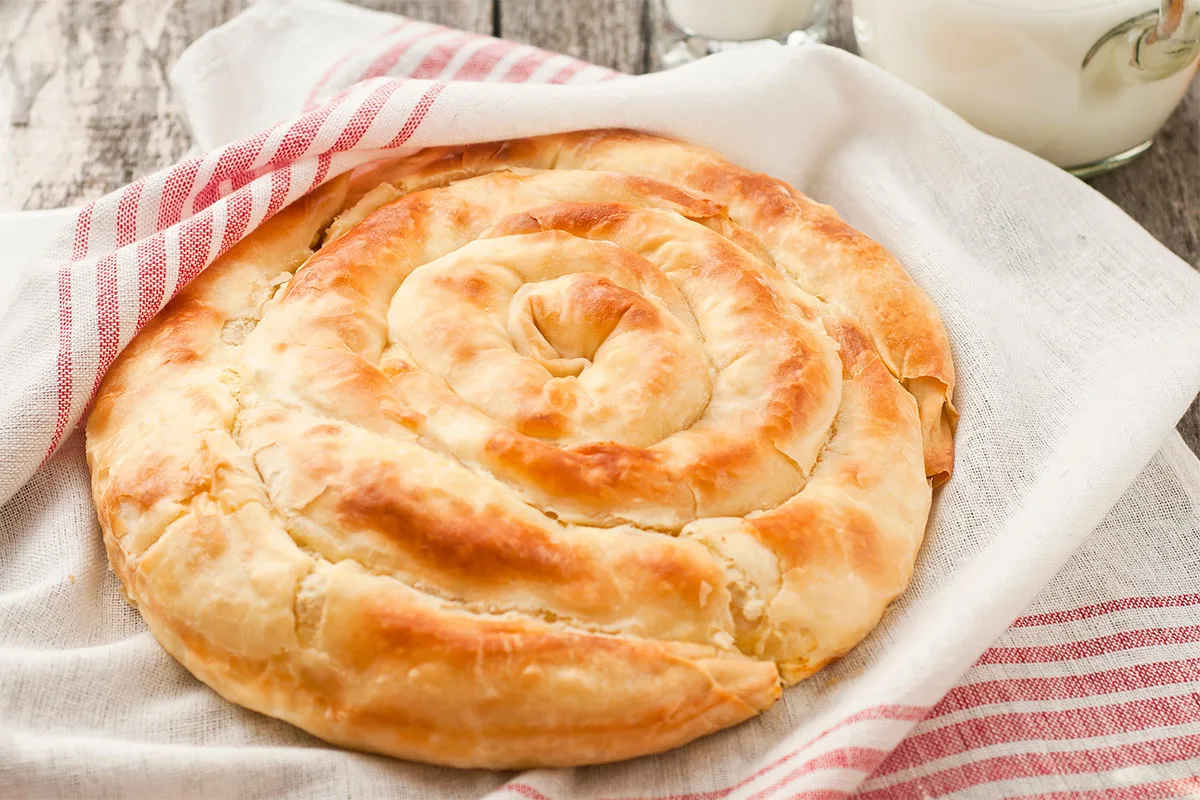
Traditional pastries like banitsa have a wonderful combination of textures and flavors thanks to layers of eggy dough, feta cheese, and thin dough.
Banitsa is a showcase for the skill of Bulgarian bakers and is perfect for breakfast or special celebrations.
A wide variety of ingredients, like as spinach, leeks, or pumpkin, can be added to Banitsa in various ways, creating a popular dish with endless possibilities.
Kozunak
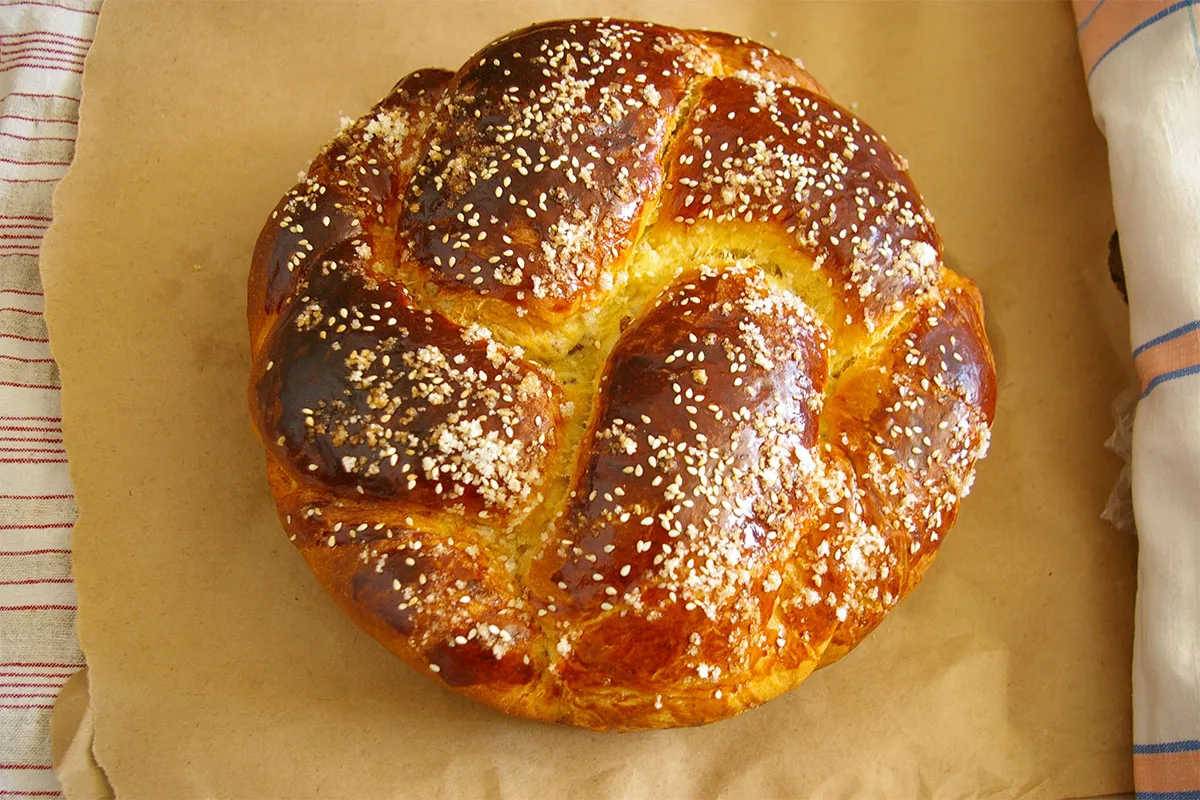
Indulge in a soft and decadent loaf of kozunak, a sweet and rich Easter bread in Bulgaria, made with ingredients like eggs, sugar, butter, and milk.
The smell of freshly made bread fills homes with warmth and anticipation as families gather to prepare Kozunak over the Easter season.
Raisins or walnuts are great additions to the bread since they provide a nice contrast to the sweet flavor and fluffy texture.
Tikvenik
A Bulgarian pumpkin strudel called tikvenik (sweet banitsa) has layers of filo dough filled with a spicy pumpkin filling that is both sweet and savory.
Enjoyed by a lot of people in the fall, when pumpkins are in season, this seasonal delight is sure to put you in the festive mood.
A warm and satisfying dessert, Tikvenik is made with pumpkin, cinnamon, sugar, and layers of flaky crust.
Baklava
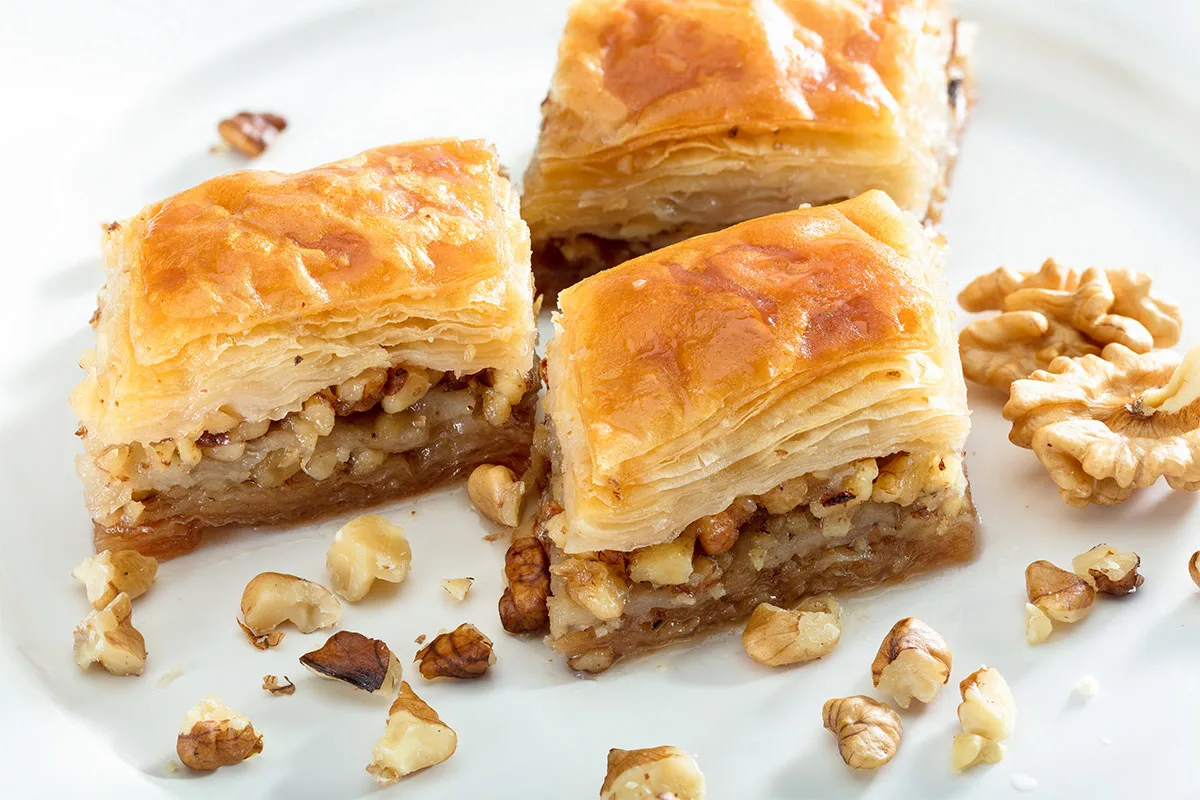
Although baklava takes several shapes in different cultures, one of the most well-known Bulgarian sweets is phyllo pastry layered with nuts and honey.
Each bite of this decadent treat reveals the impact of Ottoman cuisine on Bulgarian candies; it’s crunchy and sweet with a sticky aftertaste.
Bulgarian baklava, a delicacy that can be savored any time of day or reserved for special occasions, represents the varied and extensive culinary traditions of the area.
Zelnik

Savoury and filling, zelnik are pastries filled with finely chopped cabbage and often spiced and herb-seasoned.
This filling meal is a mainstay in Bulgarian cooking, and it exemplifies how to make a savory pastry with only a few basic ingredients.
If you’re looking for a taste of Bulgarian cuisine, try some traditional pastry either as an individual dish or as part of a meze platter.
Have a look at my list of amazing foods starting with Z if you’re interested in learning about more curious-sounding dishes.
Kifla
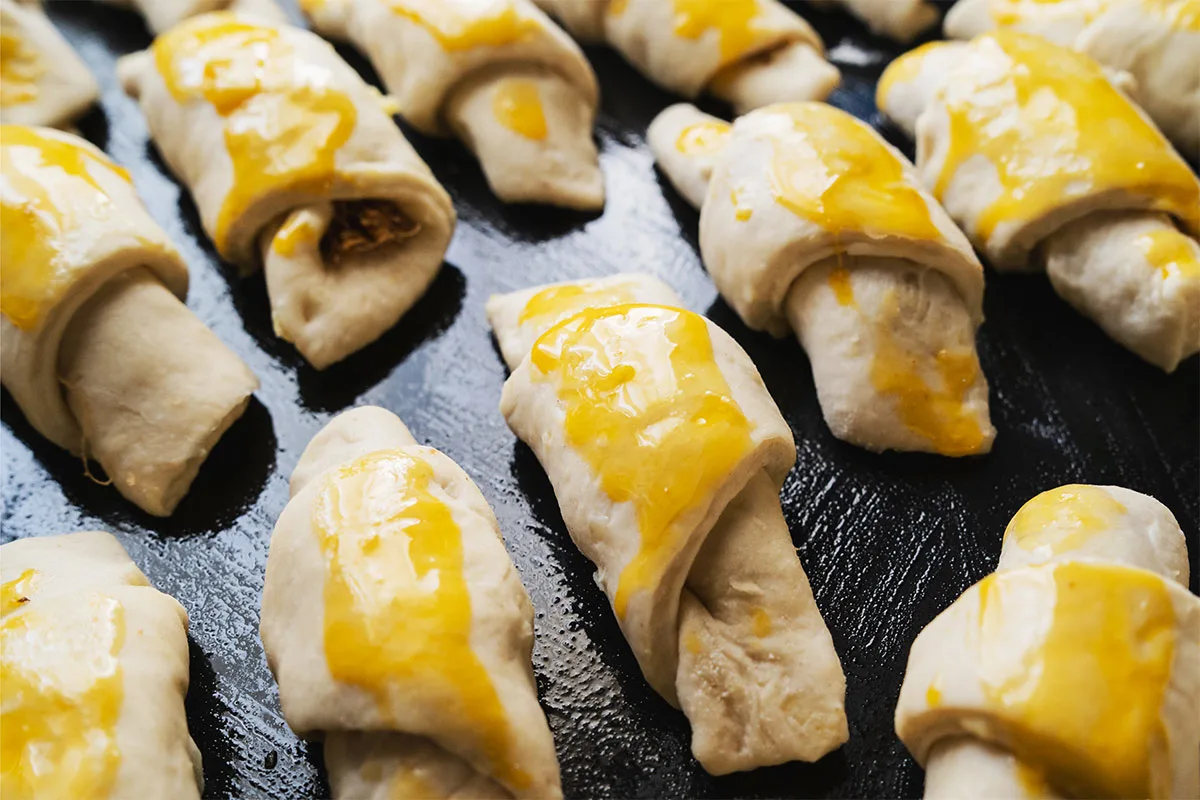
Kifla is a crescent-shaped pastry that offers a delicious blend of flaky and soft textures. It can be filled with savory or sweet ingredients like jam, chocolate, or cheese.
These baked treats are a favorite for breakfast or a mid-day snack because they go well with hot beverages like coffee or tea.
Among Bulgarians, Kifla are beloved for their deliciousness, portability, and the endless possibilities for creative versions they offer.
The term “pitka” describes a specific kind of traditional Bulgarian bread especially popular at Christmas.
Soft inside and crispy outside, it’s commonly enjoyed as a side dish with meals, used to soak up sauces, or served as part of festive occasions and celebrations.
Bulgarians also love to top pitka with cheese, spreads, or jams for a delicious and easy snack.
If you want to try it at home, you can check out this pitka recipe and impress your friends and family!
Pogacha

Bulgarian households regularly make pogacha, a traditional bread made from either leavened or unleavened dough and often has a round form.
Pogacha exemplifies the bread’s role in Bulgarian cuisine, whether eaten alone or as a foundation for savory toppings like cheese and honey.
The cultural connections and shared culinary traditions of the Balkan region are reflected in the variations of Pogacha that can be found across the region.
Tutmanik
As a breakfast item or addition to a meze plate, the delicious and filling Bulgarian pastry known as tumanik is filled with eggs and cheese.
Baking the dough and cheese layers to a golden perfection creates a mouth-watering contrast of flavors and textures.
Tutmanik is a favorite at home and in social settings thanks to its adaptability and comforting flavor.
Gevrek

The golden-brown crust and chewy interior of gevrek, or Bulgarian pretzel, make it a popular street food.
As a versatile and filling snack, Gevrek is great on its own or topped with cheese or jam. It’s sometimes sprinkled with sesame seeds.
The unique texture and flavor of Gevrek have made it a popular element of Bulgarian culinary culture, particularly for people who are always on the run yet still want something delicious to eat.
Parlenka
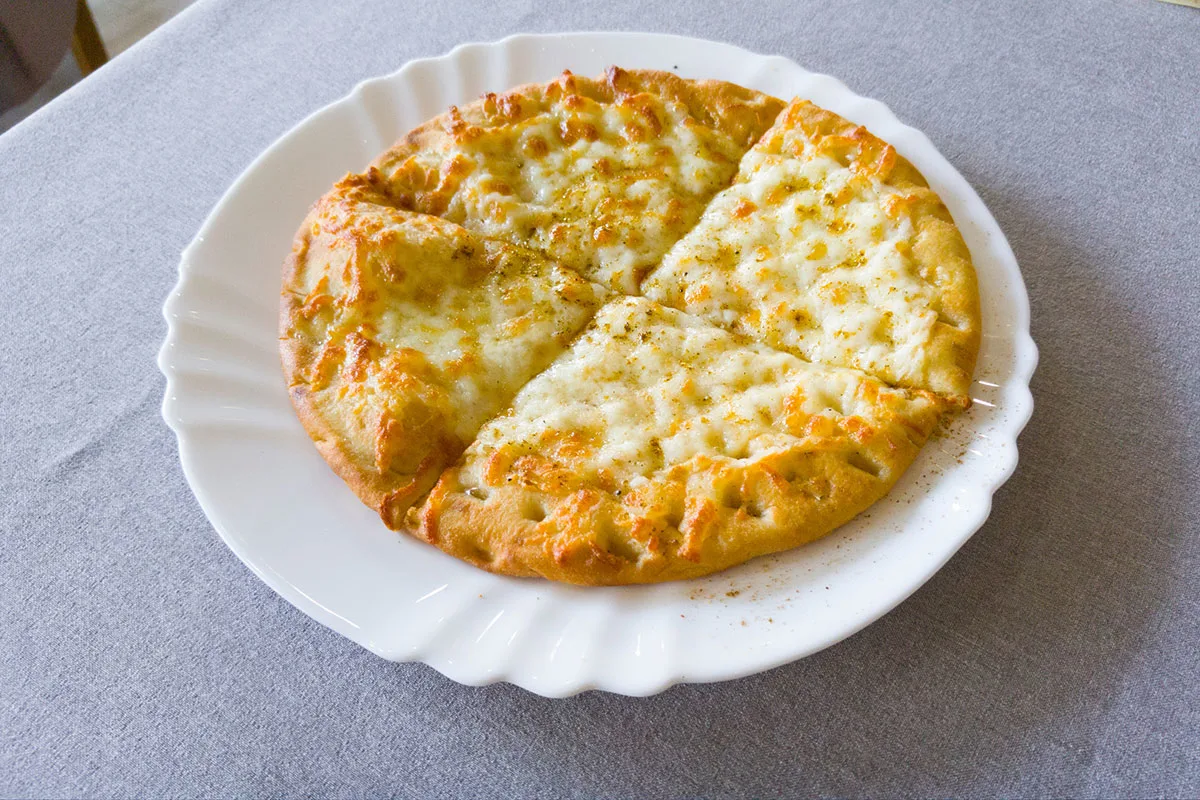
The light and fluffy Bulgarian flatbread known as parlenka goes well with a variety of fillings, including butter and jam, and is a common side dish.
Parlenka, a staple of Bulgarian cuisine, is a warm and welcoming touch to any dish, whether it’s warm and toasty or just out of the oven.
If you like discovering new foods, check out these wonderful foods that start with P to add more P-words to your food vocabulary.
Other sweets
These are some sweet bites you can find in Bulgarian coffee shops and sweet shops.
Served with soft powder sugar or jam, mekitsi—bites of deep-fried dough—are a beloved street snack in Bulgaria.
The delicious blend of crunchy and doughy textures is achieved by using only three simple ingredients—white flour, yogurt, and baking soda—in these fluffy, golden-brown treats.
Enjoy mekitsi for breakfast or any time of the day as a quick snack; it’s a beloved comfort dish.
Try the recipe for Bulgarian mekitsi at home and savor the taste of Bulgarian foods!
Maslenki
Butter, sugar, flour, and occasionally vanilla or citrus zest are the main ingredients in the little, buttery jam-filled cookies called maslenki.
“Maslenki” comes from the Bulgarian word “maslo,” meaning butter; so lard or butter has always been a key component in these cookies.
Delicate and flavorful, these Bulgarian cookies are a go-to for parties and festivals, and they are particularly popular during the Christmas season.
Tahan halva

Tahan halva (tahini halva) is a sweet treat, made from sesame seed paste (tahini) and sugar or honey, is popular in Bulgaria and many other Balkan countries and the Middle East.
Its distinctive texture and rich, nutty flavor make it a popular dessert and sweet snack choice.
Bulgarian meat snacks
These meat dishes and snacks are popular items among traditional Bulgarian recipes, showcasing a strong affinity for hearty and flavorful meals
Sudzhuk
A variety of spices, minced meat (often beef or a mix of pork and beef), garlic, and salt are the main ingredients in sudzhuk, a dry-cured sausage.
Thinly sliced Sudzhuk, with its distinctive red color and deep, smoky taste, is a popular snack or sandwich topping.
Thanks to its distinctive spice blend, this Bulgarian cured sausage is a crowd-pleaser at parties and other celebrations.
Lukanka

Like Sudzhuk, Lukanka is a dry-cured sausage (Bulgarian salami) made with ground meat (pork), garlic, and spices. Its robust flavor and hard texture have made it a beloved snack and charcuterie item.
Lukanka salami is perfect on its own or as a versatile snack that goes well with cheese and bread.
It’s a delicious complement to charcuterie boards or meze platters, thanks to its unique flavor that represents the geographical differences in Bulgarian cured meats.
Pastarma
This classic air-dried and cured beef is known as pastarma, and it gets its distinctive flavor and scent from a special seasoning procedure that includes garlic, fenugreek, and sweet paprika.
Pastarma is a popular accompaniment to bread and cheese or a meze platter.
It’s a cherished Bulgarian treat known for its savory and slightly acidic flavor, which is achieved by meticulous preparation and unique spices.
In Ukraine, it’s most commonly referred to as “basturma”. In fact, I tried it at a pub that offers it with beer, and I thought it was good.
Bulgarian kyufte are meatballs that can be fried or grilled. They are created with minced meat, typically a mix of pork and beef, and seasoned with a mixture of traditional spices, onions, and garlic.
Kyufte is a common dish at traditional Bulgarian barbecues, or “skara,” and is either enjoyed on its own or as an accompaniment to bread.
Kyufte embodies the spirit of Bulgarian grilling tradition, making it a beloved dish among meat enthusiasts.
I really love these meaty snacks in the winter!
Karnache
The traditional ingredients for karnache, a grilled or fried sausage, include minced meat (usually pork or a mix of pork and beef), garlic, and a variety of spices.
Karnache, with its rich and smoky taste, is a popular addition to the Bulgarian tradition of outdoor grilling and goes well with bread.
The charred surface and distinctive blend of spices make Karnache a popular choice for those looking for a tasty and filling snack or main dish.
Meshana Skara

“Meshana Skara,” which translates to “mixed grill,” is a famous Bulgarian dish that consists of a variety of grilled meats.
Traditionally served at family reunions and social gatherings, Meshana Skara is a filling and savory main dish that goes well with bread or vegetables.
A mixed grill brings people together in a joyful and communal setting thanks to the variety of meats cooked on it and the smokey scent that wafts from the barbecue.
Lozovi Sarmi
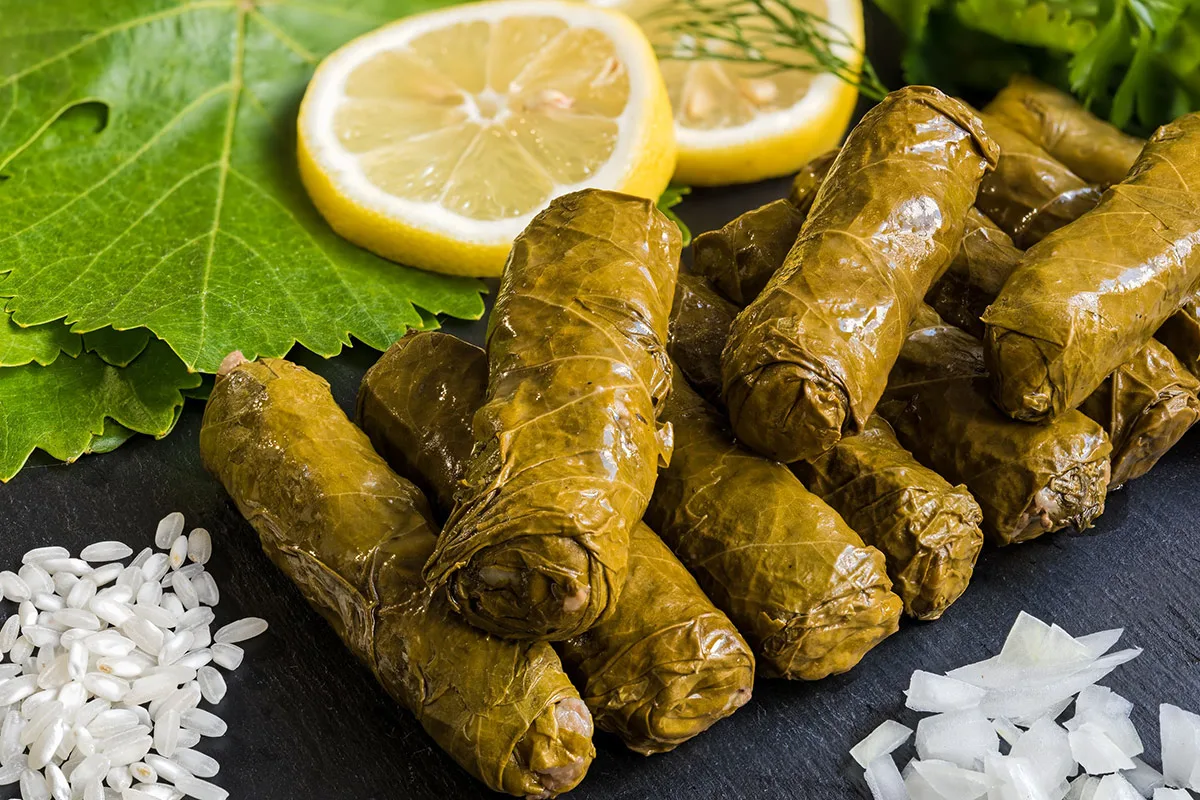
Sarma, sometimes called Dolma, is a traditional Middle Eastern dish made with grape leaves filled with rice, minced meat (usually lamb or beef), and a variety of spices.
While not exclusively Bulgarian, Sarma/Dolama is part of Balkan cuisine with its delicate meat, fragrant rice, and well-balanced flavors, whether enjoyed warm or chilled.
I love how this meal exemplifies the adaptability and inventiveness of Bulgarian cuisine since it can be eaten as a snack, an appetizer, or even a main course.
Princess sandwich (Принцеса)
This open-faced baked sandwich is a beloved Bulgarian street food. Basically, it’s a slice of bread spread with minced meat and egg and kashkaval cheese (yellow cheese).
In eastern and south-eastern Bulgaria, this type of sandwich is called “Strandjanka” which differs from the “Princess” in its length and has more spices.
Bulgarian vegetarian snacks
If you’re a vegetarian or simply like lighter meat-free snacks, Bulgaria has many excellent food items.
Kyopolou
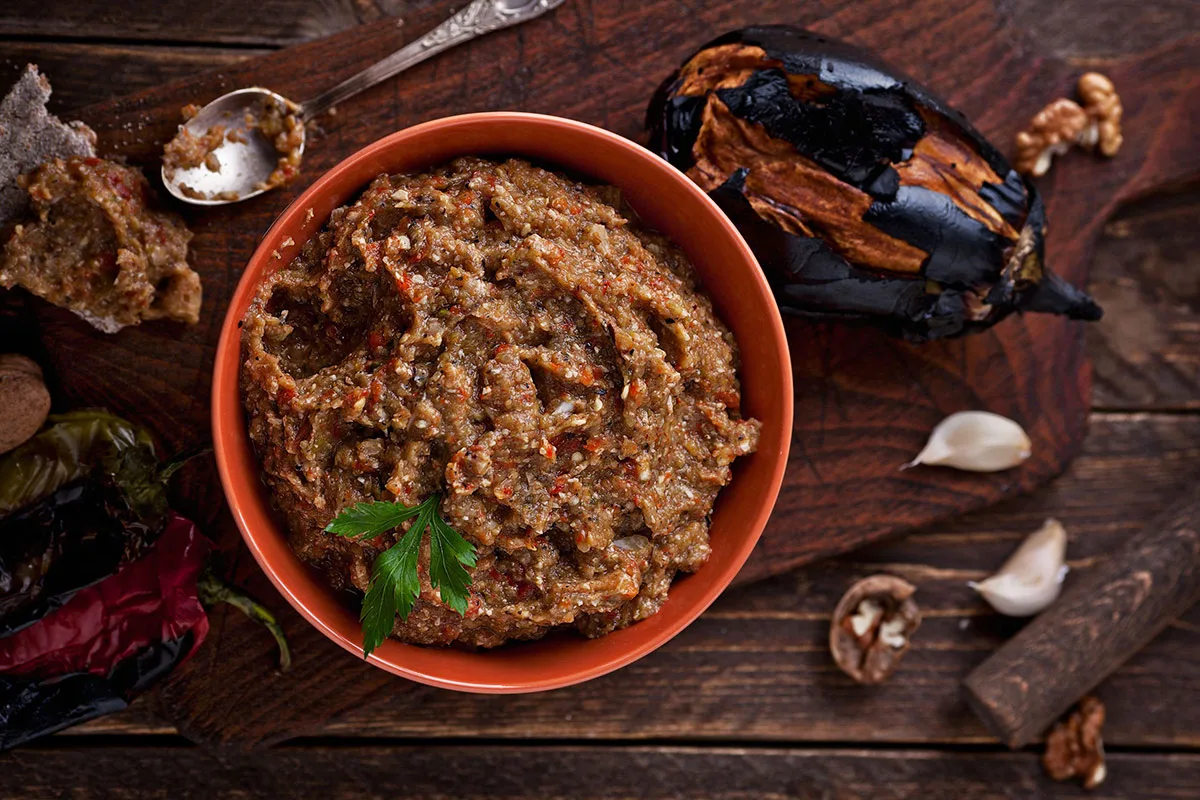
The smokiness and flavor of kyopolou come from the roasted vegetables that make it up: eggplants, bell peppers, tomatoes, garlic, and olive oil.
Kyopolou, a side dish or bread accompaniment that displays the aromatic and flavorful roasted veggies, exemplifies Bulgarians’ penchant for bold, uncomplicated flavors.
Ljutenica
Cooked to a thick consistency, ljutenica, (lyutenitsa or lutenica) is a delicious vegetable spread or chutney that combines tomatoes, peppers, carrots, and a blend of spices.
Spread it on toast or use it as a condiment—ljutenica, is a household staple in Bulgaria and a delicious addition to many recipes.
Ljutenica, showcases the variety of the region’s vegetables, whether it’s homemade or store-bought, and embodies the essence of traditional Bulgarian food.
Chushki burek

Roasted peppers filled with feta cheese, herbs, and occasionally other ingredients make up the classic Bulgarian meal known as chushki burek.
A classic Bulgarian “burek” is a layered pastry filled with a variety of ingredients. Chushki burek, on the other hand, is a variant that skips the dough and instead puts the contents within peppers.
Bulgarians love their chushki burek for all the many textures and flavors it has to offer. Therefore it’s among popular Bulgarian appetizers, side dishes and even snacks.
Ikra (Eggplant Caviar)
Roasted eggplants, tomatoes, garlic, and olive oil come together to form the velvety and tasty dip known as ikra, or eggplant caviar.
Ikra, a popular accompaniment to bread or a side dish, blends the smokiness of roasted eggplant with the sweetness of tomatoes, creating a wonderful textural contrast.
I like eggplant caviar for its velvety texture and rich flavors. If you want something lighter, you can also try it with zucchini—a more popular variation in my country.
Zucchini Fritters (Kyufteta ot Tikvichki)

These savory patties are crafted with grated zucchini, eggs, flour, and herbs. They are then pan-fried until they reach an ideal golden brown color.
With their airy, crunchy texture and explosion of herbaceous flavors, these fritters are a snack or appetizer that showcases the flexibility of zucchini in Bulgarian cuisine.
If you’re searching for a tasty snack that’s also vegetarian, try these zucchini fritters with yogurt or a garlic dip.
I love zucchini fritters in any form; and while they’re found in many cuisines, the Bulgarian kyufteta ot tikvichki have their own regional flair.
Patatnik
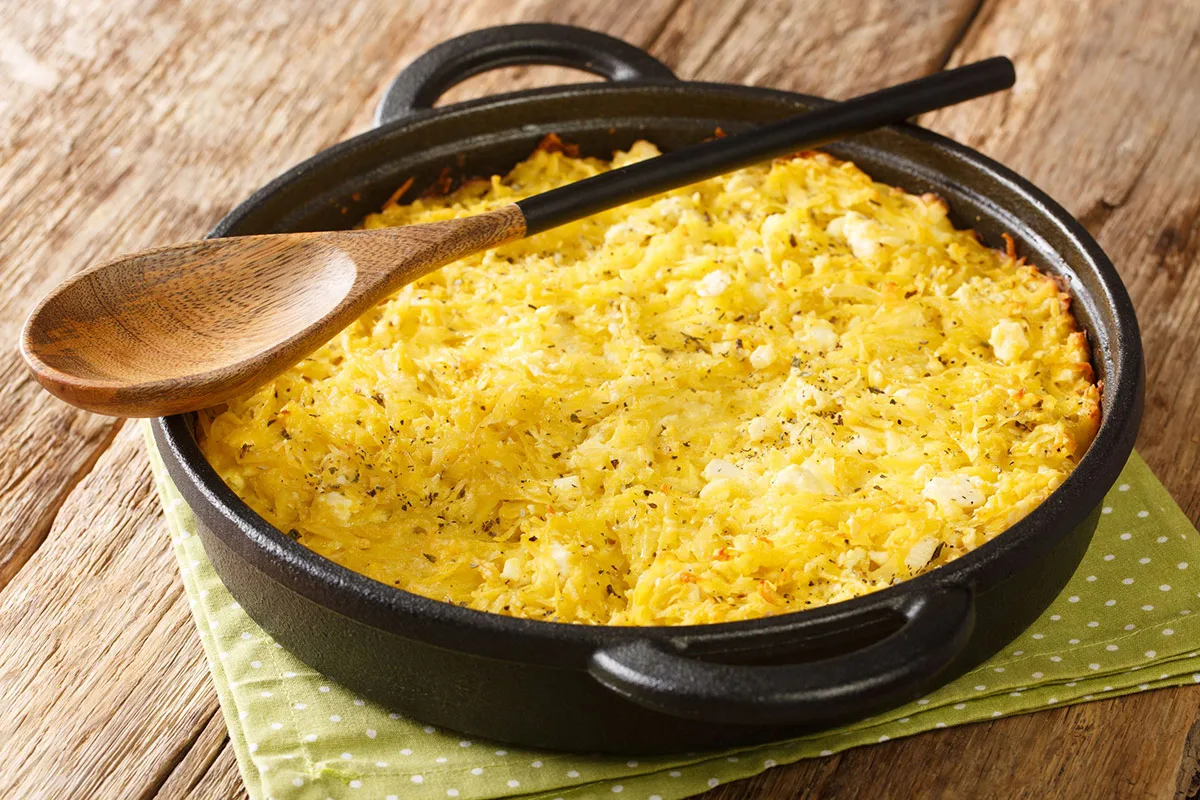
As a traditional dish from the Rhodope mountains, patatnik (or patetnik, as it is referred to in some regions) is made with potatoes. Potatoes, onions, salt, and garlic are coarsely grated to make it.
Everything is combined and cooked over a low heat. You can add egg, cheese, or meat. Some people add herbs and seasonings.
The traditional recipe calls for baking it on the village stove. Once the bottom is done, it is placed on a board and slipped into the pan with the unbaked side facing up.
Pechen Sladak Kartof (Roasted Sweet Potato)
Sweet potatoes, when roasted to perfection and typically seasoned with herbs or spices, make for a simple yet delectable snack known as Pechen Sladak Kartof, which translates to Roasted Sweet Potato.
For individuals looking for a healthy snack, this one is a great choice because it brings out the sweet taste and earthy aromas of sweet potatoes.
Serve it as a side or eat it straight up; Pechen Sladak Kartof is the quintessential Bulgarian snack—healthy and tasty.
Popara
Bread is soaked in hot milk or water, then feta cheese, sugar, and occasionally walnuts or honey are added to make popara, a typical Bulgarian dish.
Popara is an easy and reassuring recipe that has been passed down through many generations of Bulgarian cooks; it is commonly eaten for breakfast or as a snack.
Shopska salata
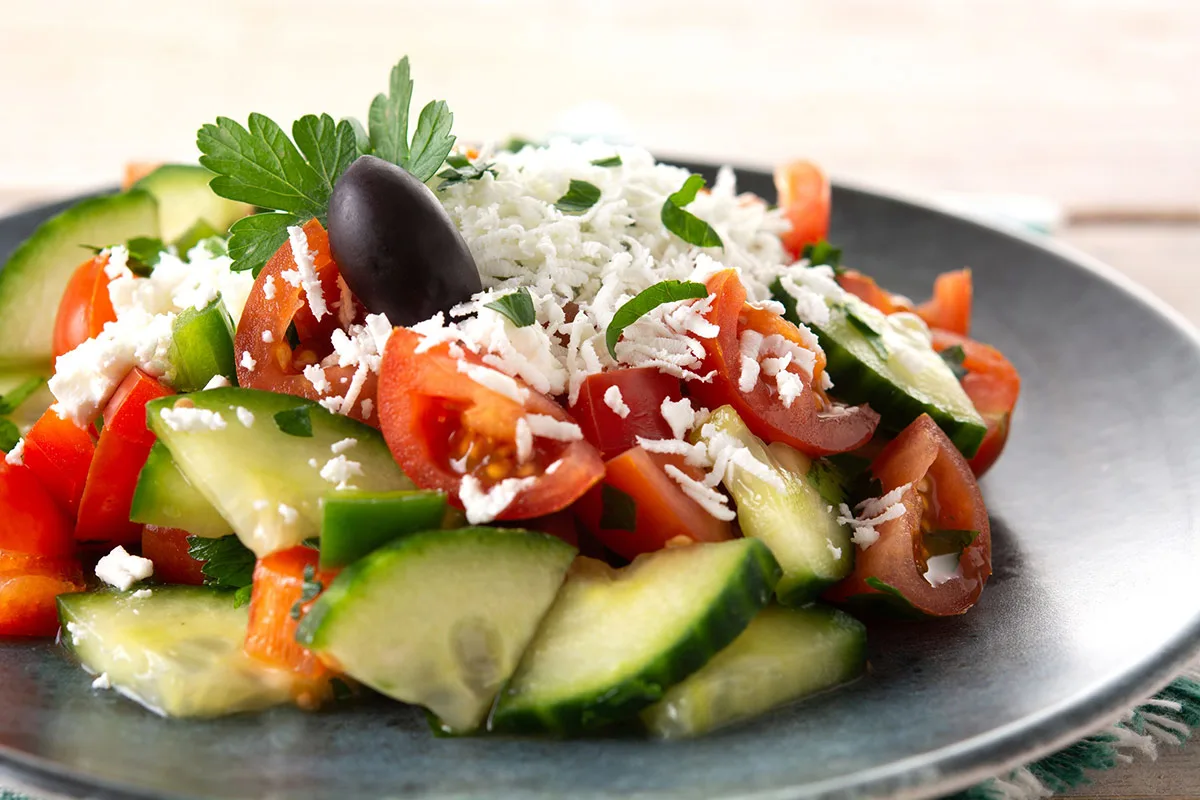
Shopska salata is a classic salad and a Bulgarian national dish that is well-known for its flavorful, fresh, and uncomplicated ingredients.
Chopped tomatoes, cucumbers, bell peppers, and red onions create a vibrant salad that is perfect for sharing as an appetiser, side dish and even a refreshing summer snack.
The crunchy veggies in this Bulgarian salad are taken to the next level by the abundant topping of shredded sirene cheese, a brine cheese that is comparable to feta.
To create a balanced combination of flavors and textures, the salad is typically dressed with olive oil and seasoned with a bit of salt and oregano.
Tarator
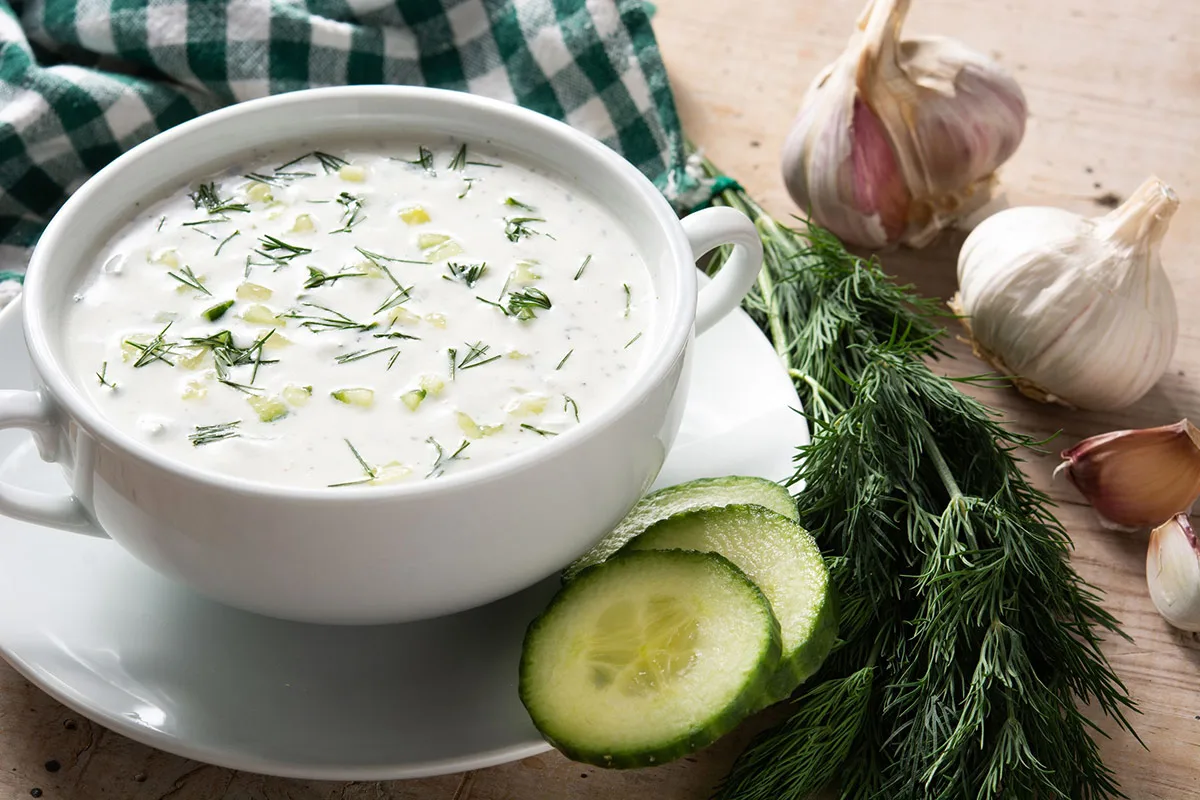
In the sweltering summer months, many Bulgarians turn to the traditional cold soup known as tarator. Yogurt, cucumbers, garlic, and dill are the main ingredients in this light and delicious dish.
Although it is typically served cold, this soup is perfect for any occasion—even as a snack—thanks to its refreshing and light texture.
This traditional Bulgarian soup is often served as a refreshment in between meals, particularly when the weather is warm.
These cool snacks like Shopska salad and Tarator sound great to me—it gets so hot over here in the summer and they’re great for cooling down!
If you want to discover more T foods, click here for some amazing foods starting with T.
Which Bulgarian snacks did you like the most? Share the ones you tried in the comments!
Curious to learn more exciting food options? Check out foods starting with the letter W and foods starting with Y to explore more!

32 Traditional Bulgarian Snacks You Must Try
Ingredients
Most popular Bulgarian snacks
- Bulgarian pastries
- Banitsa
- Kozunak
- Tikvenik
- Baklava
- Zelnik
- Kifla
- Pitka
- Pogacha
- Tutmanik
- Gevrek
- Parlenka
Other sweets
- Mekitsi
- Maslenki
- Tahan halva
Bulgarian meat snacks
- Sudzhuk
- Lukanka
- Pastarma
- Kyufte
- Karnache
- Meshana Skara
- Lozovi Sarmi
- Princess sandwich (Принцеса)
Bulgarian vegetarian snacks
- Kyopolou
- Ljutenica
- Chushki burek
- Ikra (Eggplant Caviar)
- Zucchini Fritters (Kyufteta ot Tikvichki)
- Patatnik
- Pechen Sladak Kartof (Roasted Sweet Potato)
- Popara
- Shopska salata
- Tarator



